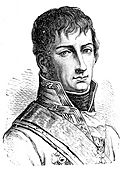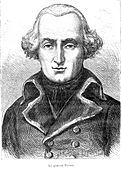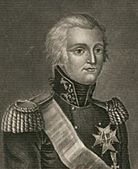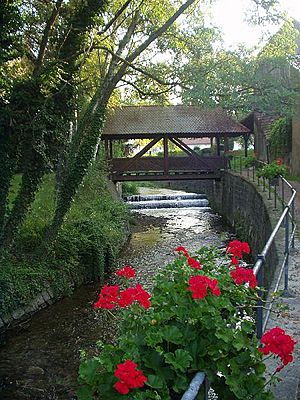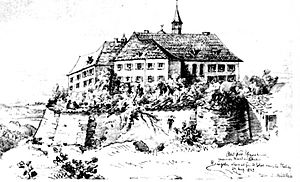Battle of Schliengen facts for kids
Quick facts for kids Battle of Schliengen |
|||||||
|---|---|---|---|---|---|---|---|
| Part of the War of the First Coalition | |||||||
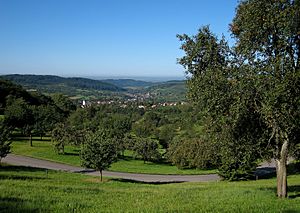 Present-day view of the battlefield |
|||||||
|
|||||||
| Belligerents | |||||||
| Commanders and leaders | |||||||
| Strength | |||||||
| 24,000 | 32,000 | ||||||
| Casualties and losses | |||||||
| 800 killed and wounded | 1,200 killed and wounded | ||||||
The Battle of Schliengen happened on October 24, 1796. It was a fight between the French army, led by Jean-Victor Moreau, and the Austrian army, led by Archduke Charles. Both sides said they won. The battle took place near the village of Schliengen, which is in modern-day Germany. This area is close to the borders of Germany, France, and Switzerland.
During the French Revolutionary Wars, Schliengen was a very important place. Controlling it meant armies could easily move into southwestern Germany and cross the Rhine River. On October 20, Moreau's French army pulled back from Freiburg im Breisgau. They set up their defenses on a line of hills. Archduke Charles's army tried to attack them from the side, but the muddy roads made it impossible. The French army's left side was too close to the Rhine River to be outflanked. Their center was on high ground, making it very hard to attack directly.
Instead, Archduke Charles attacked the French army's sides head-on. This led to many soldiers being hurt or killed on both sides. Even though both armies claimed victory, most historians agree that the Austrians gained a better position. However, the French army left the battlefield in an orderly way. A few days later, they crossed the Rhine River into France at Hüningen. Political issues in Vienna meant that the Austrians couldn't use their advantage. Their troops were stuck in two sieges on the Rhine, even though they were badly needed in Italy. This battle is remembered on monuments in Vienna and Paris.
Contents
Why the Battle Happened
At first, European rulers thought the French Revolution was just a problem between the French king and his people. They didn't want to get involved. But as the revolution grew stronger, they worried about King Louis XVI and his family. In 1791, they issued the Declaration of Pillnitz. This statement warned France of serious consequences if anything happened to the royal family.
The situation for the French revolutionaries became very difficult. French people who had left the country (called émigrés) kept trying to get support for a counter-revolution. Finally, on April 20, 1792, France declared war on Austria. This started the War of the First Coalition (1792–1798). In this war, France fought against most European countries that shared borders with it.
By early 1793, France was in big trouble. French forces had been pushed out of Belgium. There were also rebellions inside France, like the revolt in the Vendée. The French king had just been executed. The French army was in chaos. Things got even worse when France started levée en masse, which meant forcing many young, untrained men to join the army.
The Rhine Campaign of 1795 was a disaster for the French. But they had some success in other areas, like the War of the Pyrenees (1793–1795).
The 1796 Campaign
The armies of the First Coalition had about 125,000 soldiers. This was a large force for the time. However, their commander, Archduke Charles, had his troops spread out. They stretched from Switzerland all the way to the North Sea. The Habsburg (Austrian) troops were the main part of this army. But they couldn't cover the long front from Basel to Frankfurt well enough.
Compared to the French, Charles had half the number of troops. They had to cover a 211-mile (340 km) front. He put most of his army near Karlsruhe and Darmstadt. This area was important because the Rhine and Main rivers met there. It offered a good path into eastern Germany and eventually to Vienna.
The French had two main generals: Jean-Baptiste Jourdan and Jean Victor Moreau. Jourdan led the Army of Sambre-et-Meuse. Moreau led the Army of the Rhine and Moselle. The French army was made up of young men forced to join. They often didn't get paid and sometimes rebelled. French commanders knew they had to attack Germany. The French government believed war should pay for itself. They didn't plan to pay or feed their soldiers.
In the spring of 1796, a group of German states called the Swabian Circle raised about 7,000 untrained soldiers. Charles didn't like to use these militias in important places. So, when the French seemed to be attacking near Mainz, Charles thought the main attack would be there. He sent the Swabian militia to guard a crossing at Kehl.
But on June 24, Moreau's army, with 10,000 advance troops and 30,000 main forces, attacked Kehl. The Swabian militia was greatly outnumbered and couldn't get help. Within a day, Moreau had four divisions across the river. The Swabians retreated to Rastatt. Charles couldn't move his main army from Mannheim or Karlsruhe in time.
At the same time, near Basel, another French general, Ferino, crossed the Rhine. He moved east along the German side of the river without opposition. The Austrian and Imperial armies were in danger of being surrounded. To stop this, Charles ordered an organized retreat. His army pulled back through the Black Forest and towards Bavaria. He tried to keep his army together as they retreated.
By mid-July, Charles's army was near Stuttgart. He had to retreat far enough into Bavaria to protect the Danube valley. This would also stop the French from getting to Vienna. He left the Swabian Circle to the French. The Swabian militia had to disband to negotiate neutrality. Charles's men even disarmed some of them. As Charles moved further east, a neutral zone grew in southern Germany.
Summer Fights
The summer and fall of 1796 saw many battles. Both the Coalition and French armies tried to outsmart each other.
| Date | Location | French Troops | Imperial Troops | Winner | ||||||
|---|---|---|---|---|---|---|---|---|---|---|
| 4 June | Altenkirchen | 48,000 | 64,000 | French | ||||||
| 15 June | Wetzlar and Uckerath | 20,000 | 20,000 | Austrian | ||||||
| 23–24 June | Kehl | 10,000 | 7,000 | French | ||||||
| 28 June | Rastatt | 20,000 | 6,000 | French | ||||||
| 9 July | Ettlingen | 36,000 | 32,000 | French | ||||||
| 11 August | Neresheim | 47,000 | 43,000 | French | ||||||
| 24 August | Amberg | 40,000 | 2,500 | Imperial | ||||||
| 24 August | Friedberg | 59,000 | 35,500 | French | ||||||
| 3 September | Würzburg | 30,000 | 30,000 | Imperial | ||||||
| 2 October | Biberach | 35,000 | 15,000 | French | ||||||
| 19 October | Emmendingen | 32,000 | 28,000 | Imperial | ||||||
| 24 October | Schliengen | 32,000 | 24,000 | Imperial | ||||||
| 24 October – 9 January 1797 | Kehl | 20,000 | 40,000 | Imperial | ||||||
| 27 November – 1 February 1797 | Hüningen | 25,000 | 9,000 | Imperial | ||||||
| Source: Digby Smith, Napoleonic Wars Data Book, Mechanicsburg, Pennsylvania: Stackpole Books, 1996, pp. 111–118. | ||||||||||
By mid-summer, things looked bad for the Coalition. General Wartensleben kept retreating east, even though Charles told him to join up. It seemed like the French might split Charles's and Wartensleben's armies. At Neresheim on August 11, Moreau defeated Charles, forcing him to retreat further. Finally, Wartensleben realized the danger and moved his troops to join Charles.
At Amberg on August 24, Charles defeated the French. But on the same day, his commanders lost a battle at Friedberg. Still, the war started to turn in the Coalition's favor. Both Jourdan and Moreau had stretched their armies too far into Germany. They were too far apart to help each other. The Coalition's strong forces pushed a wedge between the two French armies. As the French retreated to the Rhine, Charles and Wartensleben pushed forward. On September 3 at Würzburg, Jourdan tried to stop his retreat but failed. When Moreau heard about this French defeat, he had to pull his troops out of southern Germany. He led them back through the Black Forest.
The Battlefield
The Rhine River forms the border between Germany and Switzerland. The High Rhine, an 80-mile (129 km) stretch, flows through steep hills. Further north, near Basel, the land flattens out. The Rhine then turns north into a wide valley called the Rhine ditch. This valley has the Black Forest to the east and the Vosges mountains to the west. In 1796, this plain was about 19 miles (31 km) wide. It was full of villages and farms.
The landscape was beautiful but also very rough. A traveler from the 1800s described the mountains near Müllheim as "bold." He said the dark valleys and sunny hills made for "exquisite scenes." The Rhine River looked like a "serpent of silver," with many islands. The view from high up showed a vast flat plain with villages, hamlets, and woods.
The Rhine River looked different in the 1790s than it does today. It was "corrected" (straightened) much later. In 1790, the river was wild and unpredictable. In some places, it was four times wider than it is now. Its channels wound through marshes and meadows. It created islands that were often covered by floods.
The Battle Itself
Key Leaders
- Commanders
- Key Figures at the Battle
Before the Fight at Schliengen
Through September and early October, Charles kept pushing Moreau's army west. On September 18, an Austrian force attacked the Rhine bridgehead at Kehl. They took it but suffered heavy losses. The French commander, General Schauenburg, immediately counter-attacked. He drove the Austrians back. The French still held the crossing at Kehl. But the Austrians stopped Moreau from using it to escape. This left the bridge at Hüningen as his only way back to France. If Moreau retreated too soon, General Ferino's column would be trapped.
The next battle was on October 19 at Emmendingen. This was in the Elz valley, which runs through the Black Forest. Archduke Charles split his army into four groups. The Austrians attacked the French from different directions. General Beaupuy was killed, and his French column was thrown into confusion. General Wartensleben was held up by French riflemen. The French retreated across the rivers, destroying all the bridges.
But the lack of bridges didn't stop the Austrians. They quickly fixed the bridges and moved towards Moreau at Freiburg. On October 20, Moreau's army of 20,000 joined with Ferino's column south of Freiburg. This brought the total French force to about 32,000. Charles's forces, with 24,000 men, followed Moreau closely. They moved southwest to a line of hills between Kandern and the river.
French Army's Position
After retreating about 38 miles (61 km), Moreau stopped at Schliengen. He spread his army in a 7.5-mile (12 km) semicircle along a ridge. This ridge overlooked the paths from Freiburg. He put his right side, led by Ferino, on the hills of Kandern and Sitzenkirch. His left side was at Steinstadt. His center was in the village of Schliengen, about 3 miles (5 km) from the Rhine River.
His whole army was protected by a small stream called the Kander. This stream flowed out of the mountains and into the Rhine. Moreau also placed extra infantry in front of his center for more protection. His position on the high ground gave him an advantage. His troops could fire downhill at any attacking forces. The French position on these steep, wooded hills seemed almost impossible to attack.
Austrian Plan
The Austrian army, joined by the Army of Condé, came from Freiburg. Charles had a few choices. A direct attack on the French would cost many lives. Moreau had picked a very strong position, especially for his center. Any Austrian force would have to cross the Kandern stream and then advance uphill under heavy fire.
Charles could avoid a big battle. He could leave a small force to keep the French busy. Then he could send part of his army through the mountains to the left of the Kandern. They could go down into the valley and cut off the French escape route to Hüningen. But this would take time, and the roads were bad because of rain.
Instead, Charles decided to attack Moreau's right side at Kandern. He divided his army into four columns. Condé's Emigré Corps formed the far right column. Condé's grandson, Louis Antoine, Duke of Enghien, led its front part. The second column, led by Karl Aloys zu Fürstenberg, had 9 battalions and 26 squadrons. Charles ordered these first two columns to keep the French left side busy. They were to stop the French from attacking the Austrian army from behind.
The third column, led by Maximilian Anton Karl, Count Baillet de Latour, had 11 battalions and 2 cavalry regiments. The fourth column, led by Friedrich Joseph, Count of Nauendorf, was the main part of Charles's army. It approached on the far Austrian left. The two larger columns, under Latour and Nauendorf, were to attack the French right side with full force. Their goal was to push the French army so its back was to the Rhine. This was the hardest part of the plan. They would have to attack uphill. Nauendorf split his column into smaller groups. They attacked Kandern from several sides, climbing the steep slopes.
The Fight
Condé's Corps and Fürstenberg's column were positioned to keep the French left side from attacking the main Austrian force. But the Duke of Enghien, Condé's grandson, bravely attacked Steinstadt with the Army of Condé. They took the village with a bayonet charge. They stayed there under heavy artillery and musket fire all day. The French fire was constant and terrible. An officer was killed standing near the royal family members.
Taking advantage of this, the second Austrian column took the hill opposite Schliengen. This area was strongly defended by French General Gouvion Saint-Cyr. Saint-Cyr tried many times to win back the position. But Fürstenberg's column held onto it all day, despite heavy cannon fire from the French.
On the other side of the battlefield, Latour's column marched through the night. At 7:00 AM, the right part of his column attacked Ferino's positions. They forced the French to retreat behind Liel. The left part of Latour's column attacked another position. After fierce fighting, Latour's column pushed the French out. The Austrians had to make a difficult uphill advance.
The biggest part of the battle was fought by Nauendorf's column. His men had marched all night. His column moved with General Latour's corps. But near the castle of Bürgeln, it turned left to get to the source of the Kandern stream. Finally, by 2:00 PM, Nauendorf's column had struggled through mud and joined the fight. Despite strong resistance, his troops pushed the French out of Kandern and Sitzenkirch. They took all the high ground above the river. The fighting between Ferino's and Nauendorf's columns was very intense. Moreau later said that Ferino's troops showed "amazing bravery" from morning until night. When Nauendorf finished pushing the French from Kandern, he sent a message to Latour. As the battle ended, a terrible storm of hail and wind began. This was the end of the first day of the battle. Charles's army had successfully pushed the French back on both sides. Overnight, Charles planned to attack the French center the next morning. It looked like it would be a long and bloody second day.
French Retreat
Moreau realized his position was impossible to hold. Especially on his right side, where most of Charles's army was ready to attack again. The Austrian army was positioned to cut off his escape route to the bridge at Hüningen. His troops might hold out for another day, but there was a risk. The Austrians could break through either side, get behind him, and trap him.
So, that night, he moved his right side back to the heights of Tannenkirch. This new position was almost as strong as the one they left. With a strong rear guard, he left his position that same night. He retreated about 9.7 miles (15.6 km) to Hüningen. His right and left sides followed. By November 3, he had reached Haltingen and moved his troops across the bridge into France.
What Happened Next
With their backs to the river, Ferino and Moreau had to retreat into France. But they still controlled the forts at Kehl and Hüningen. More importantly, they held the tête-du-ponts (fortified bridgeheads) where the bridges crossed the river. Moreau offered a ceasefire to Charles. Charles was willing to accept it. He wanted to secure the Rhine crossings and send troops to northern Italy. He needed to help General Dagobert Sigmund von Wurmser at the siege of Mantua. A ceasefire with Moreau would let him do that.
However, Charles's brother, Francis II (the Holy Roman Emperor), and his military advisors refused the ceasefire. They forced Charles to order simultaneous sieges at Kehl and Hüningen. This kept his army tied to the Rhine for most of the winter. He moved north with most of his forces to attack Kehl. He told Karl Aloys zu Fürstenberg to lead the siege in the south near Basel. While the Austrians were busy with these sieges, Moreau had enough extra troops. He sent about 12,000 soldiers to Italy to help with the siege at Mantua.




